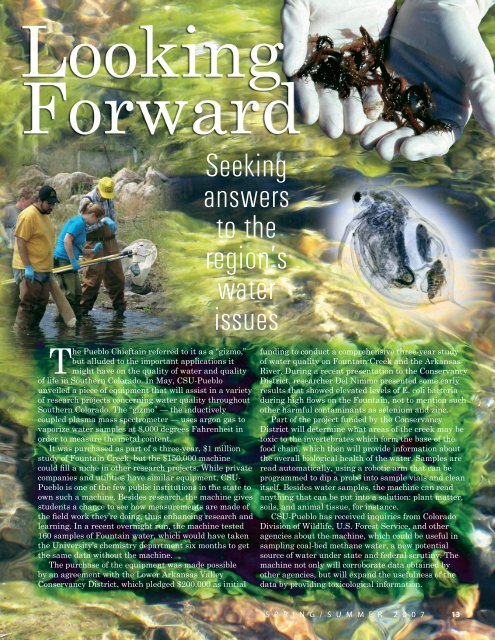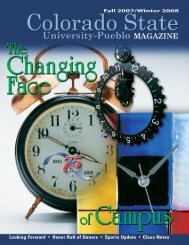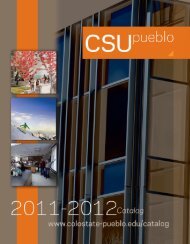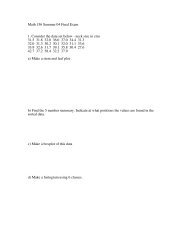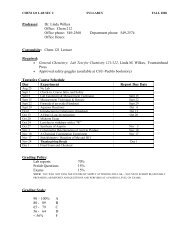Colorado State University-Pueblo MAGAZINE Spring/Summer 2007
Colorado State University-Pueblo MAGAZINE Spring/Summer 2007
Colorado State University-Pueblo MAGAZINE Spring/Summer 2007
Create successful ePaper yourself
Turn your PDF publications into a flip-book with our unique Google optimized e-Paper software.
Seeking<br />
answers<br />
to the<br />
region’s<br />
water<br />
issues<br />
The <strong>Pueblo</strong> Chieftain referred to it as a “gizmo,”<br />
but alluded to the important applications it<br />
might have on the quality of water and quality<br />
of life in Southern <strong>Colorado</strong>. In May, CSU-<strong>Pueblo</strong><br />
unveiled a piece of equipment that will assist in a variety<br />
of research projects concerning water quality throughout<br />
Southern <strong>Colorado</strong>. The “gizmo” — the inductively<br />
coupled plasma mass spectrometer — uses argon gas to<br />
vaporize water samples at 8,000 degrees Fahrenheit in<br />
order to measure the metal content.<br />
It was purchased as part of a three-year, $1 million<br />
study of Fountain Creek, but the $150,000 machine<br />
could fill a niche in other research projects. While private<br />
companies and utilities have similar equipment, CSU-<br />
<strong>Pueblo</strong> is one of the few public institutions in the state to<br />
own such a machine. Besides research, the machine gives<br />
students a chance to see how measurements are made of<br />
the field work they’re doing, thus enhancing research and<br />
learning. In a recent overnight run, the machine tested<br />
160 samples of Fountain water, which would have taken<br />
the <strong>University</strong>’s chemistry department six months to get<br />
the same data without the machine.<br />
The purchase of the equipment was made possible<br />
by an agreement with the Lower Arkansas Valley<br />
Conservancy District, which pledged $200,000 as initial<br />
funding to conduct a comprehensive three-year study<br />
of water quality on Fountain Creek and the Arkansas<br />
River. During a recent presentation to the Conservancy<br />
District, researcher Del Nimmo presented some early<br />
results that showed elevated levels of E. coli bacteria<br />
during high flows on the Fountain, not to mention such<br />
other harmful contaminants as selenium and zinc.<br />
Part of the project funded by the Conservancy<br />
District will determine what areas of the creek may be<br />
toxic to the invertebrates which form the base of the<br />
food chain, which then will provide information about<br />
the overall biological health of the water. Samples are<br />
read automatically, using a robotic arm that can be<br />
programmed to dip a probe into sample vials and clean<br />
itself. Besides water samples, the machine can read<br />
anything that can be put into a solution: plant matter,<br />
soils, and animal tissue, for instance.<br />
CSU-<strong>Pueblo</strong> has received inquiries from <strong>Colorado</strong><br />
Division of Wildlife, U.S. Forest Service, and other<br />
agencies about the machine, which could be useful in<br />
sampling coal-bed methane water, a new potential<br />
source of water under state and federal scrutiny. The<br />
machine not only will corroborate data obtained by<br />
other agencies, but will expand the usefulness of the<br />
data by providing toxicological information.<br />
S P R I N G / S U M M E R 2 0 0 7 13


